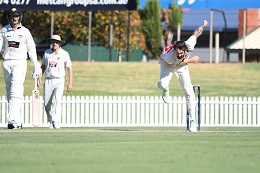09 April 2019
 There’s a very good reason why 23 per cent of Australia’s fast bowlers are sidelined with injury at any one time. Everything about their action is unnatural: the run up to the pitch at speeds of around 22 km/h, the jump, and a 128 km/h delivery all generate a force that is up to nine times their body weight.
There’s a very good reason why 23 per cent of Australia’s fast bowlers are sidelined with injury at any one time. Everything about their action is unnatural: the run up to the pitch at speeds of around 22 km/h, the jump, and a 128 km/h delivery all generate a force that is up to nine times their body weight.
Repeat that action up to 120 times in one day and throw in the impact of a year-round playing schedule with the advent of T20 cricket and it’s punishing in anyone’s language.
But new research from the University of South Australia could address this injury epidemic and give fast bowlers the respite they need.
UniSA PhD student Fabian Garcia-Byrne is developing a fatigue marker for fast bowlers using GPS technology, giving coaches a scientific measure to monitor their players’ fitness in training and competition, rather than relying on “gut feeling”.
“At the moment there is no objective marker of fatigue for fast bowlers,” Fabian says. “It’s pretty much down to the coach’s expertise to notice the signs but there is no scientific evidence to back it up. It is all very subjective.”
Fabian is working with the South Australian Cricket Association (SACA), monitoring their fast bowlers with GPS tracking devices, which can reveal crucial information about technique, performance and intensity.
“For each of our fast bowlers we have a calibration number where we can calculate whether they are bowling close to match intensity. It helps us to predicate fatigue before it’s too late and ensures that cricketers don’t push their bodies to the point of injury. Based on the metrics it also tells us whether the players are fit to perform well, not just fit to play.”
A submaximal running test to track fast bowlers’ endurance is the first outcome of Fabian’s study, breaking new ground in sports science. Previous studies could only establish a correlation with neuromuscular fatigue.
Fabian created a recovery test for SACA’s fast bowlers, getting them to run for two minutes between a 20-metre marker to a set metronome, requiring them to get a foot strike every time the metronome made a sound. The test was conducted at the beginning of each week’s training regime to determine whether cricketers were fatigued and needed time out, or whether they were performing at their best.
“This data can be collected indoors and outdoors so could potentially be used for many different sports, not just cricket,” Fabian says.
His next study will involve SACA’s fast bowlers doing a running session and then bowling five overs, aiming for the top of off stump, mimicking an all-day session in the field.
Fabian will present his research at Cricket Australia’s Sports Science Medicine Conference in Brisbane on 9 April and again at the World Congress of Science and Medicine in Cricket in the UK in July, coinciding with the 2019 Cricket World Cup.
SACA Sports Science and Sports Medicine Manager John Porter said his organisation was “thrilled to be partnering with the UniSA on this project”.
“Being able to more accurately identify when a bowler is fatiguing will be a significant step forward in reducing injury rates and improving performance in Australian cricket,” he said.
Notes for editors
According to the most recent statistics from Cricket Australia, 23 per cent of fast bowlers are unable to play due to injuries. Hamstring strains, hand/finger fractures, lumbar spine injuries and abdominal strains are the common injuries.
Bone stress injuries in fast bowlers incur the highest costs in terms of games/time missed because they involve lengthy recovery periods. Cricket Australia attributes the high prevalence of bone stress injuries to the introduction of T20 cricket with players regularly transitioning between the three formats – T20, One Day and First-Class cricket – which puts extra stress on the body. This has also made the cricket calendar more crowded, allowing for less recovery time between matches which is one of the major risk factors for lumbar bone stress injuries.
……………………………………………………………………………………………………………
Media contact: Candy Gibson office (08) 8302 0961mobile:0434 605 142
email: candy.gibson@unisa.edu.au
Lead researcher: Fabian Garcia-Byrne mobile 0401 663 250 email: Fabian.garcia-byrne@mymail.unisa.edu.au
…………………………………………………………………………………………………………………………


